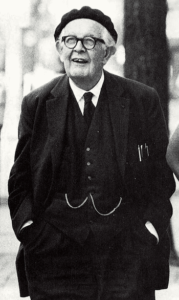
Viktor Lowenfeld
*Viktor Lowenfeld's birth is celebrated on this date in 1903. He was a white-Jewish Austrian professor of art education.
Born in Linz, Austria, Viktor Lowenfeld was always drawn to the arts. Through his narration, Lowenfeld mentioned that he was pulling toward music at four or five. He started to play the violin at the age of nine or ten. And because he used to play by ear rather than reading notes, he was often called a "Gypsy."
In 1913, Lowenfeld started painting. This early exposure to the visual and performing arts led him to a career devoted to educating himself and the public in art. Lowenfeld graduated from the College of Applied Arts and the Academy of Fine Arts in Vienna. He later received his doctorate in education from the University of Vienna and served as an elementary and secondary school teacher. While in Vienna, he also served as the director of art in the Blind Institute as Nazi Germany unfolded.
In 1938, Lowenfeld fled to England before arriving in the United States. He became a citizen in 1946 after serving in the Navy as a wartime visual aids consultant. Lowenfeld joined Hampton Institute in Virginia in 1939 as an assistant professor of Industrial Arts, studio art teacher, and later Chairman of the Art Department. In 1945, he was named curator of the distinguished collection of Black African Art at the Hampton Institute. Among his students was the American muralist John T. Biggers. Lowenfeld came to Penn State University as a professor of Art Education in 1946. Ten years later, he became head of the newly founded Department of Art Education.
One of the many holocausts exiled Jewish educators employed by HBCUs, he stayed in this position until his death. Lowenfeld's philosophy reached a large audience through the theories documented in his books: Genesis of Sculpturing, 1932; Sculptures by the Blind, 1934; The Nature of Creativity, 1938; Creative and Mental Growth, 1947; and Your Child and his Art. He also published numerous articles on art education aesthetics, art for the handicapped, black art, and testing. He published more than one hundred articles.
Dr. Lowenfeld is known for his Visual-optic theory in art education, which was developed from Viennese sources. He always regarded good teaching as a dialogue; his motivation and evaluations had a strong Expressionist bias. His psychological training enabled him to gain a therapeutic position in his early months in America, labeling him a "Viennese Psychologist" in Time. He was an active leader with the National Art Education Association and The National Committee on Art Education. Viktor Lowenfeld died in 1960.